Visiting Whale Valley in Egypt- Discover Wadi Al-Hitan’s Whale Fossils
Purchases made through links earn us a small commission, at no extra cost to you.
In the Western Desert of Egypt is a fascinating place where the skeletal remains of hundreds of ancient whales lie fossilized in dusty sand and rock.

Scattered across the attractive landscape of Wadi Al-Hitan (Whale Valley) is the world’s largest and most important fossil collection of the earliest whales, back when they were land animals with legs transitioning to ocean-going by losing their hind limbs. This significant stage of the whale’s evolution can be seen in the fossils lying in the desert and learned about in the onsite museum.
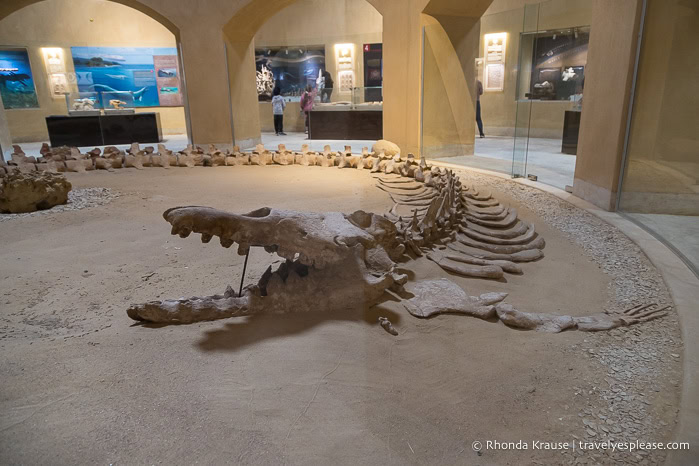
Whale fossils are not the first thing that comes to mind when thinking of Egypt, but that uniqueness is one of the reasons why I included Wadi Al-Hitan on my Egypt itinerary. Another reason why Whale Valley is worth visiting is because there is nowhere else in the world to see so many high-quality fossils of extinct whales in a concentrated area. Now that is really what makes Wadi Al-Hitan so special!
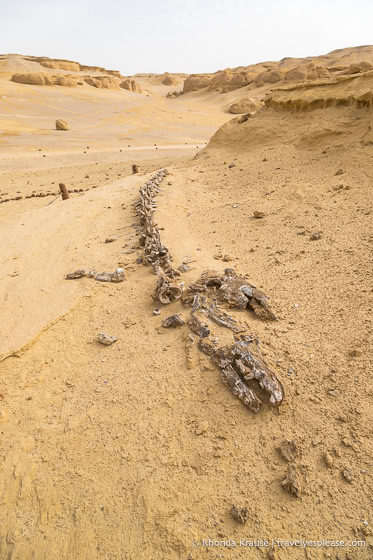
Before I share my experience visiting Whale Valley, here is some background information about Wadi Al-Hitan.

About Wadi Al-Hitan (Whale Valley) in Egypt
Wadi Al-Hitan is a protected paleontological site with about 400 fossils of extinct whales from 3 species (and discoveries still being made). The fossils date back 40 million years to when the area was under an ancient sea.

The fossils at Wadi Al-Hitan are of the earliest suborder of whale, Archaeoceti, and show the youngest archaeocetes in the final stages of losing their hind limbs. This evidence of the whale’s evolution from land animals to ocean dwellers make Wadi Al-Hitan a globally important site and the concentration, number, and quality of fossils make it even more exceptional.

The Wadi Al-Hitan fossils represent a major stage of the earth’s history and this significance led to it being inscribed as a UNESCO World Heritage Site in 2005.

The two most common whale fossils you can see at Wadi Al-Hitan are the Basilosaurus (the largest archaeocete whale) and the smaller, dolphin-like Dorudon. The whales became extinct when climate temperatures suddenly dropped.
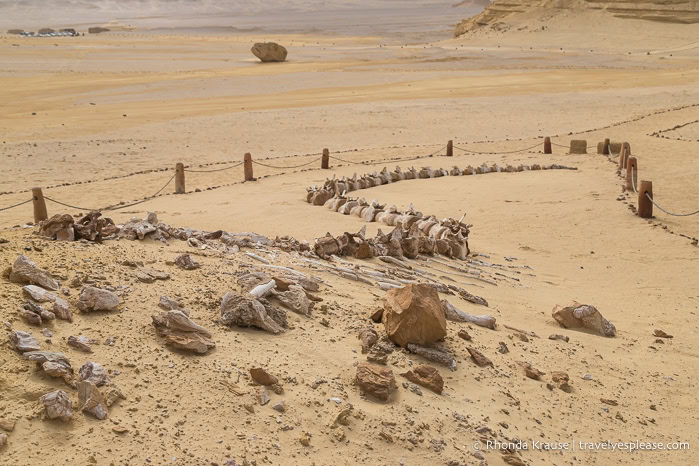
The fossils at Whale Valley include complete skeletons, partial skeletons, and single bones. The largest skeleton found is 21 m long and has hind legs and five-fingered flippers on the forelimbs.



In addition to whale fossils at Wadi Al-Hitan, there are also fossils of sea cows, turtles, sawfish, crocodiles, sharks, rays, mollusks, and mangrove trees.

Visiting Whale Valley- My Self-Guided Wadi Al-Hitan Tour
My trip to Whale Valley started by visiting the Fossils and Climate Change Museum to get an introduction to the site’s history and the fossils I would be seeing. I then headed out to explore the desert, walking the prescribed route to view the uncovered fossils.
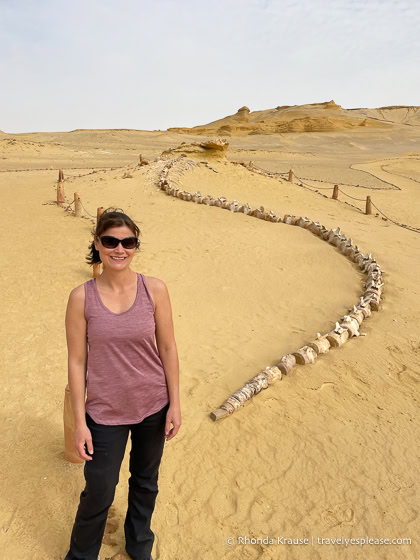

My private guide who was taking me around Egypt waited for me at the museum while I went out on my own to discover the fossils, which I appreciated because I wasn’t rushed and could walk as far as I wanted.
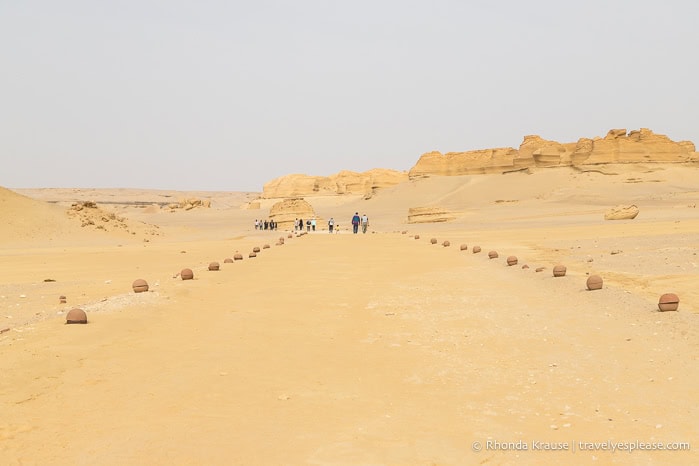

Fossils and Climate Change Museum
The Fossils and Climate Change Museum should be every tourist’s first stop at Whale Valley because it shares information about the extinct whales, their evolution, and how past climate change affected the area.

The museum’s exhibits surround a central display of the largest intact skeleton of a Basilosaurus isis whale. Its size was impressive and I liked seeing the bones of its fingered forelimbs.

Some other exhibits you can see in the museum are whale teeth, the skull of a crocodile, the skull of an Arsinoitherium (an extinct rhinoceros-like animal), and the bones of a whale forelimb and jaw.


The museum also has an interesting video about the history of Wadi Al-Hitan that is worth checking out.
The Whale Valley Fossils
There are many fossils in the desert at Wadi Al-Hitan but the main ones are signed, numbered, and connected by a trail so they can easily be visited. There wasn’t a map when I was there, but I was told there are 18 fossil displays on the marked route. It took me two hours to visit the displays (I think I missed two), including time to read the information panels and take a lot of photos.

The trail starts across from the museum at the northeast corner of the parking lot. Right away I was impressed with the landscape and rock formations and couldn’t wait to start exploring!
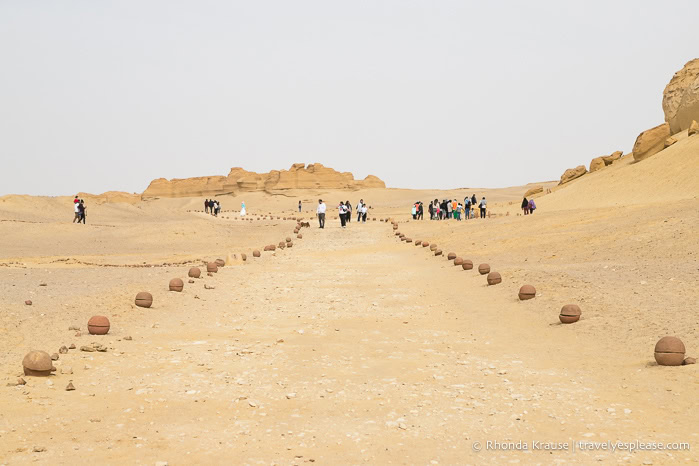
The first fossil I came to was a skull and vertebrae of a Basilosaurus whale embedded in sandstone. The skull was partially covered by sand, but I was still excited to see my first whale fossil out “in the wild”.


The second display was the fossil of a small Dorudon atrox whale. This skeleton was more complete with ribs and a forelimb bone.

The third display along the path was of a Sirenia (sea cow). I’m not sure if this was a young sea cow, but the fossil was quite small, the smallest one I saw in Whale Valley.

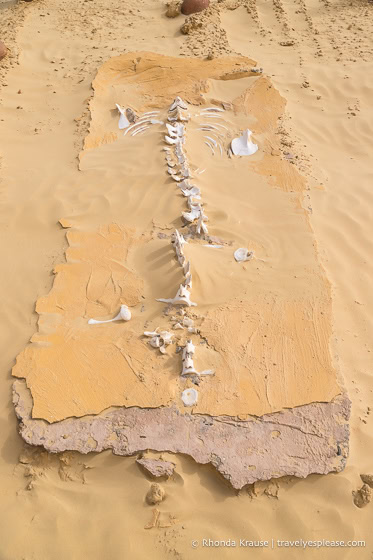
The fourth fossil was another one of a Dorudon atrox whale. This one had a crumbling skull, a few bones of a forelimb, and vertebrae.


The fifth fossil display was one of the most interesting because the spine of a Basilosaurus whale was curved along a ledge in the middle of a rock formation.


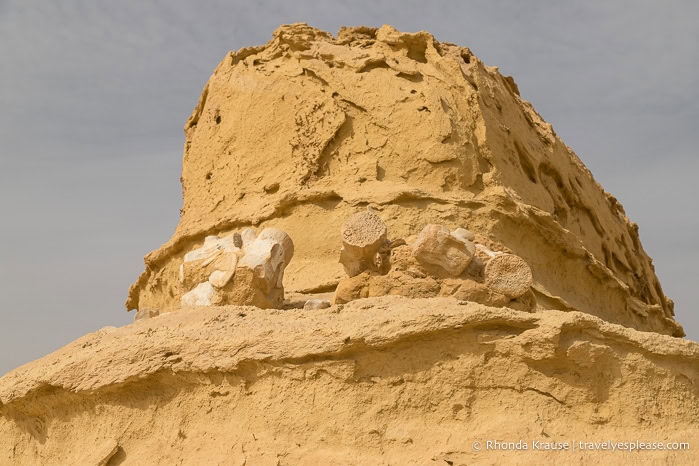
Next up at the sixth display was a fossil of a Sawfish.

The seventh display is one of the most impressive fossils at Whale Valley. This intact skeleton of a Basilosaurus whale was my favourite fossil because of its size, completeness, and position. Its long curved spine leading towards ribs resting on a slope made it especially photogenic.
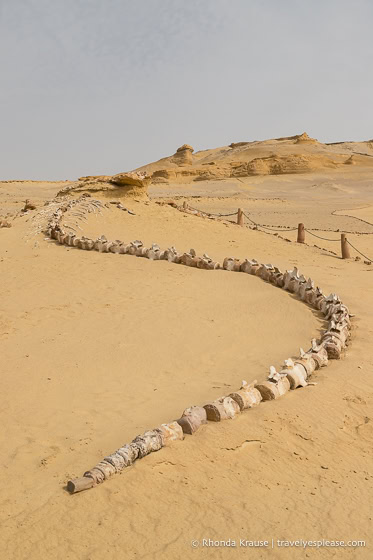
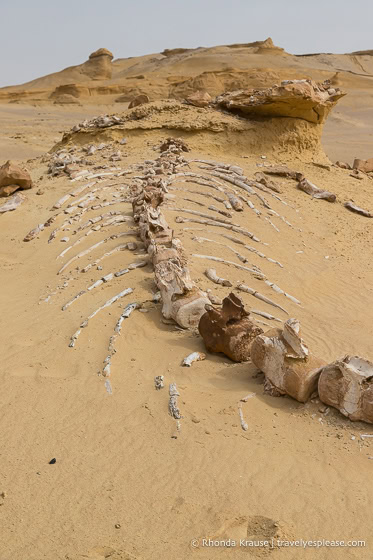
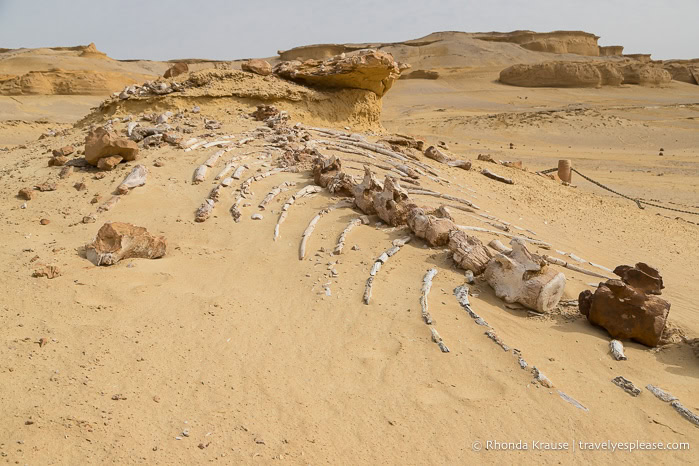
Most of the tourists I saw didn’t venture past the seventh skeleton because after this point the fossils are more spaced out and further from the trailhead. If you only have the time or desire to go as far as number 7, you will have seen what I thought were the best whale fossils at Wadi Al-Hitan. However, some of the best landscape views are near the end of the route so it’s worth continuing.
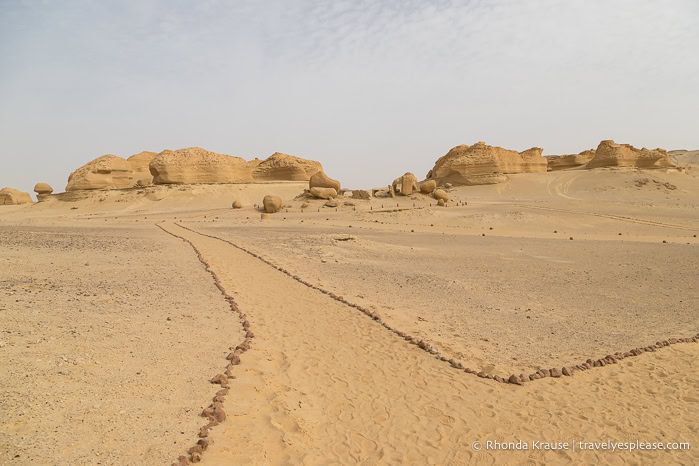
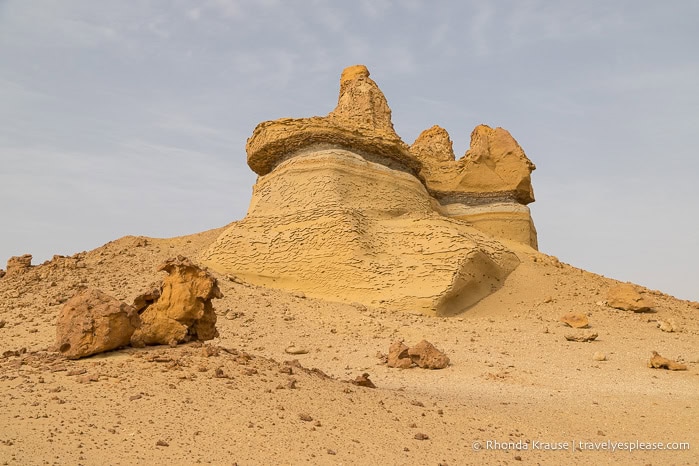
The eighth and ninth stops were an opportunity to see ancient mangrove layers in the rock and fossilized mangrove roots. The presence of mangroves indicates the shoreline of an old sea. Whale skeletons were found in the highest concentrations on top of the mangrove layer, likely because the plentiful food supply drew the whales here. Dead whales could also have been pushed into the mangrove-lined bays by tides and winds.

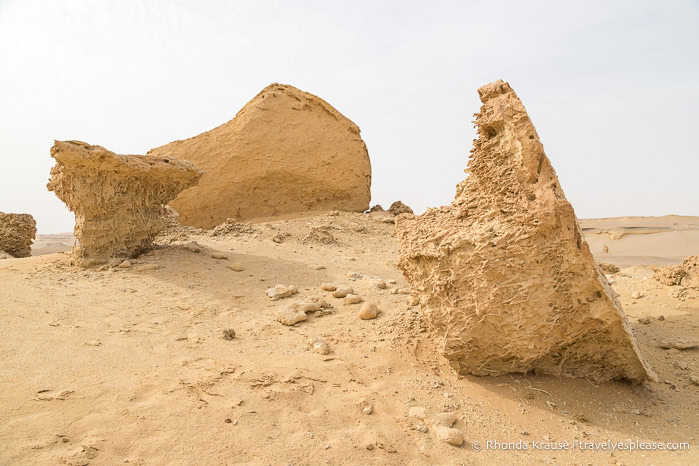
At the tenth stop along the route there were petrified burrows of Teredo, a type of saltwater clams commonly known as shipworms. Teredo bore into wood and live in the tunnels they make. This display wasn’t that interesting to me because it was just a piece of petrified wood.

The eleventh fossil display was a Basilosaurus isis. It had vertebrae and ribs, but my favourite part of this stop was actually the rock formations around it.

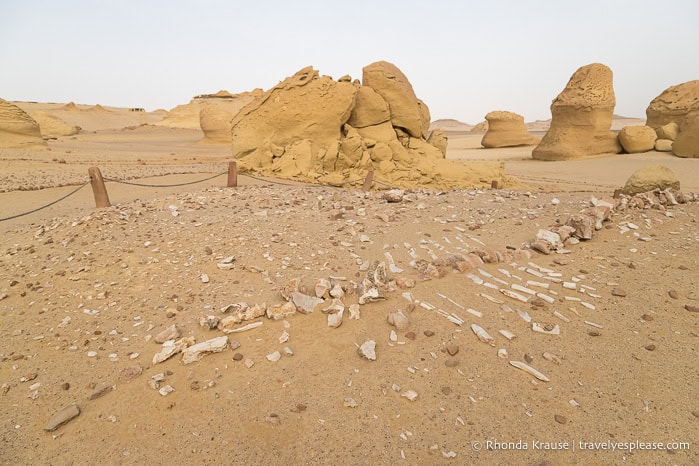
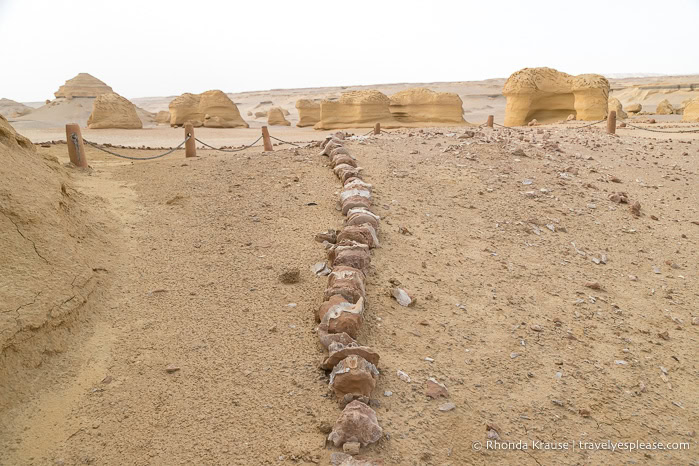
The twelfth stop was also quite scenic thanks to the interesting rock formations in the background. The fossil was of the lumbar and tail vertebrae of a Basilosaurus whale.


The thirteenth display had an intact skeleton of a Basilosaurus whale. The condition of the fossil wasn’t as good as some of the others I’d seen and much of it was still covered by sand. However, I could still gauge its size and see the characteristic curved shape that whale carcasses take in death, potentially because of their strong backbone muscles.


A short distance after this fossil, the path came to a T-intersection. It was getting late so instead of keeping straight and heading further into the desert, where it looked like there was another display, I turned left and followed the trail uphill. From here there were panoramic views of the desert landscape of Whale Valley. I loved the little “mountains” of rock, each uniquely sculpted by erosion. I could also see a layer of black shale.



Following the path at the top of the hill, I came to a shelter where there was another nice view of the scenery. After admiring the view, I followed the arrow sign to a path going downhill. I was excited about what I would see next!

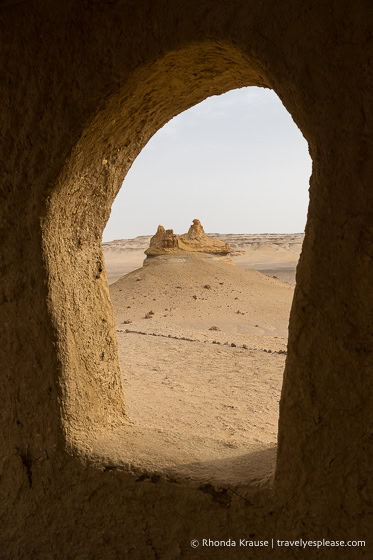
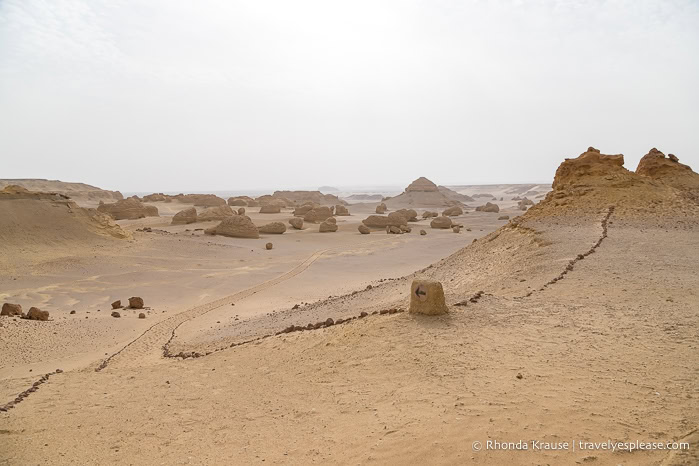
Back down in the valley, I came to the sixteenth fossil display (I missed fourteen and fifteen). This one was just fragments embedded in rock and there wasn’t a sign explaining what the fossils were, but they still looked interesting.
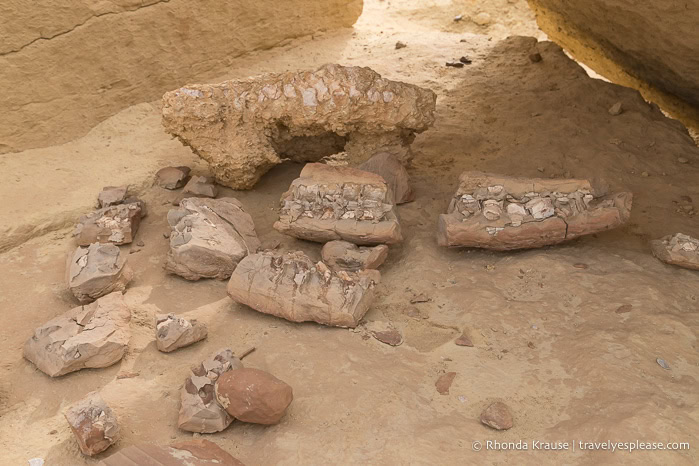
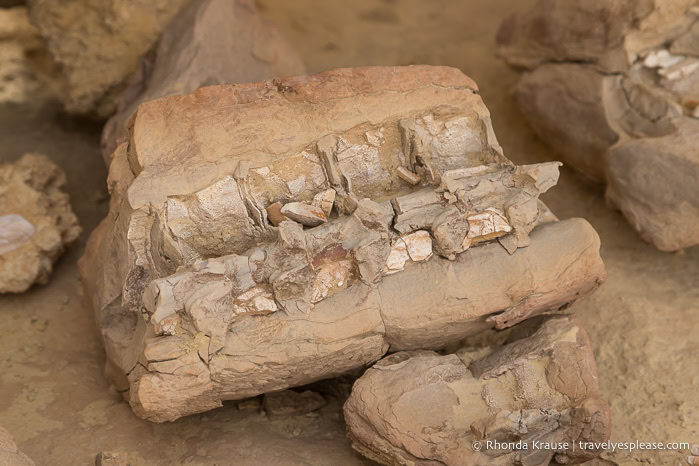
The seventeenth marked stop gave a close-up look at some of the large textured rocks that dot the valley.
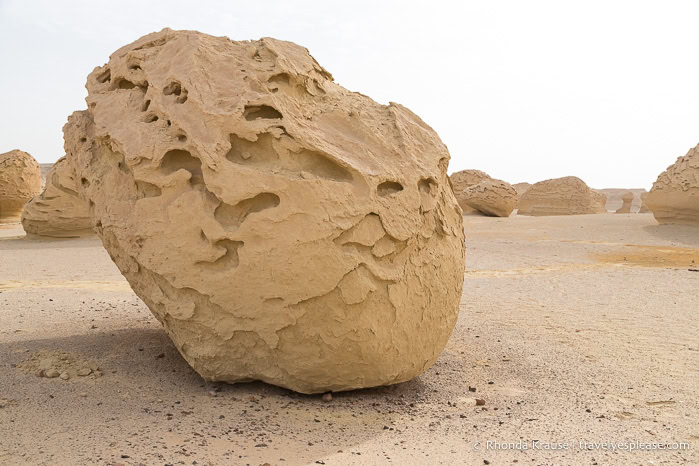
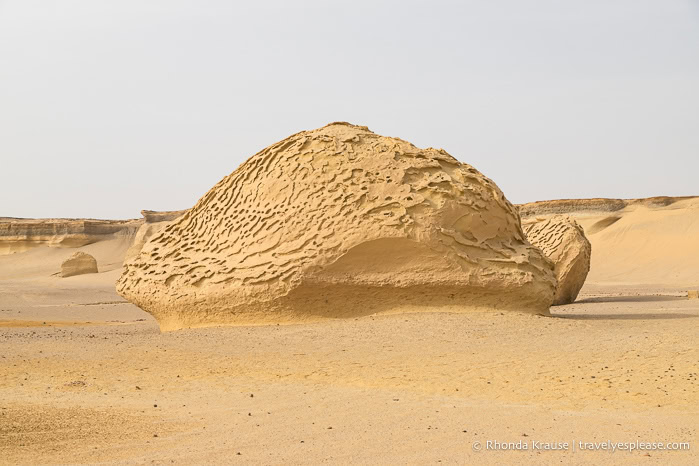
The eighteenth and final fossil was a sea turtle. It was very neat to see the faint pattern on the turtle’s shell. I also noticed an impression of a seashell on one of the rocks nearby.
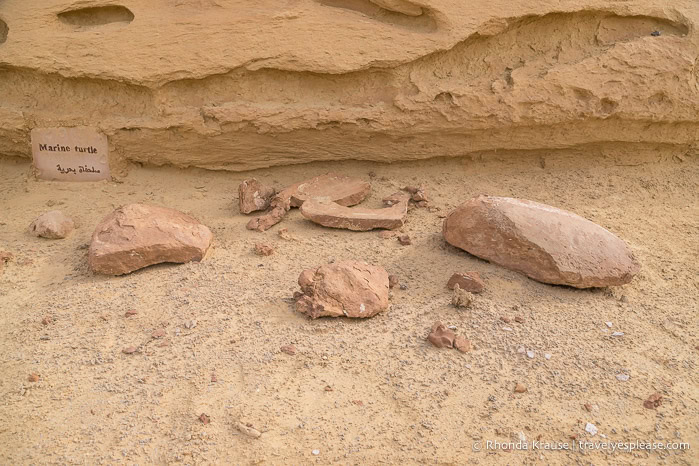
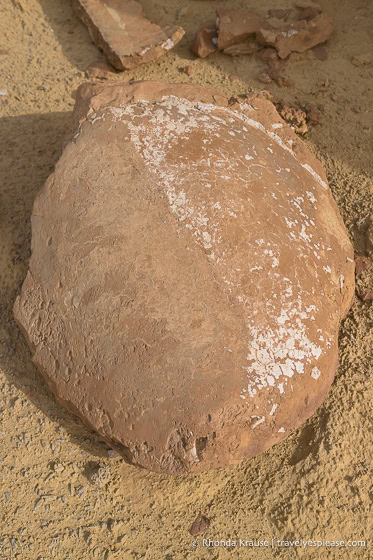
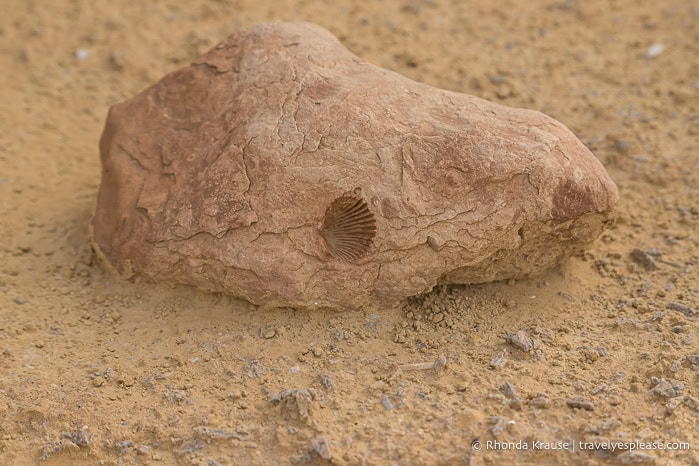
After the sea turtle, I walked back to the trailhead and found out that I was one of the last tourists still in the valley. I was having so much fun discovering the fossils that I didn’t want to come back!

Final Thoughts About Egypt’s Whale Valley
After visiting so many temples and tombs in Egypt, it was refreshing to experience something as different as Whale Valley.


I absolutely loved wandering through the desert and seeing the whale fossils in a natural environment, instead of on display in a museum. The shapes and textures of the eroded rock formations were impressive as well.
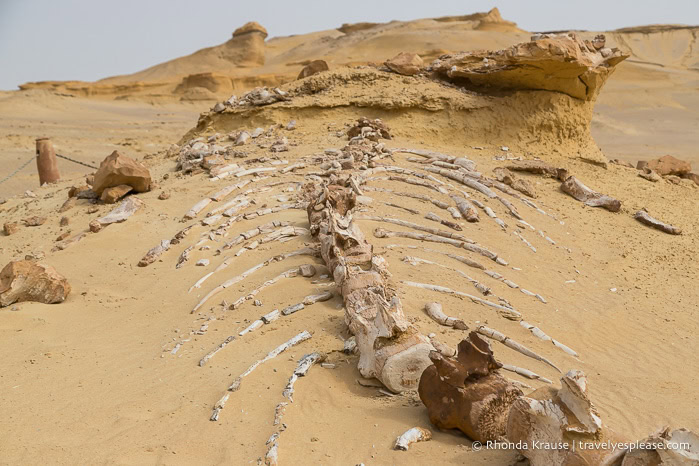
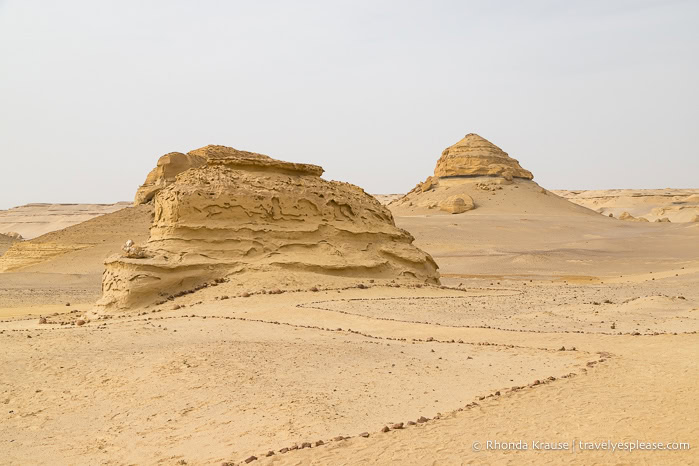
While the fossils and geology were the highlights Wadi Al-Hitan, it was also interesting to learn about the evolution of whales in the museum. I didn’t know that whales used to have legs and live on land until I visited Whale Valley.

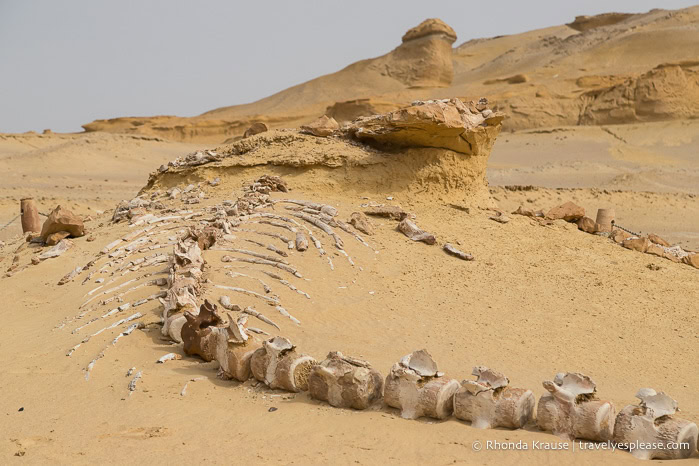

It would be nice if a map or pamphlet was available so that tourists could decide what fossils to see and how far they wanted to walk. Some of the signs at the fossil displays were also hard to read because sand had scratched and gotten under the glass.


Wadi Al-Hitan is a great destination for travellers curious about paleontology and evolution, or those who want to explore beyond Egypt’s typical tourist trail. Whale Valley is not a place most people venture to on their first trip to Egypt, but I’m glad I did because it gave me a more well-rounded experience, allowing me to see a side of Egypt I was less familiar with.
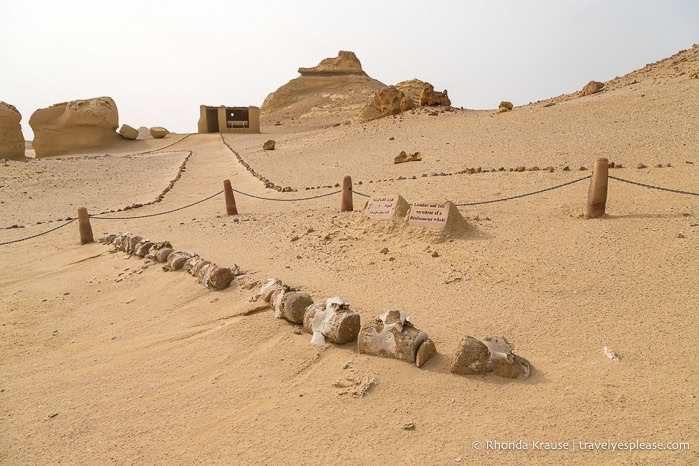
If you have the time, I definitely recommend visiting Whale Valley during a trip to Egypt.

More Pictures of Whale Valley
Here are a few more photos of Whale Valley to inspire you to visit.

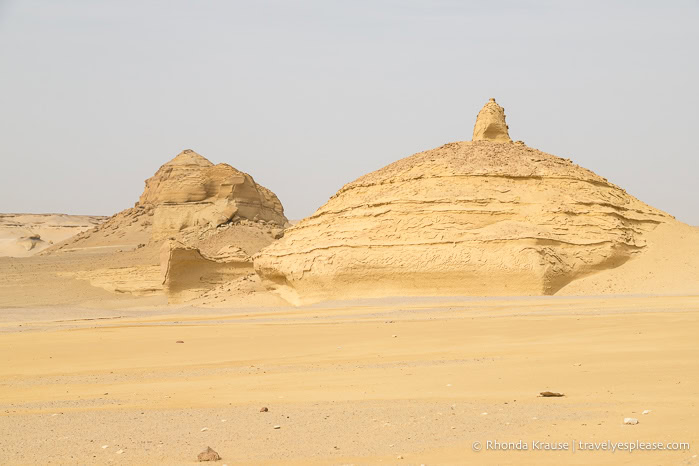



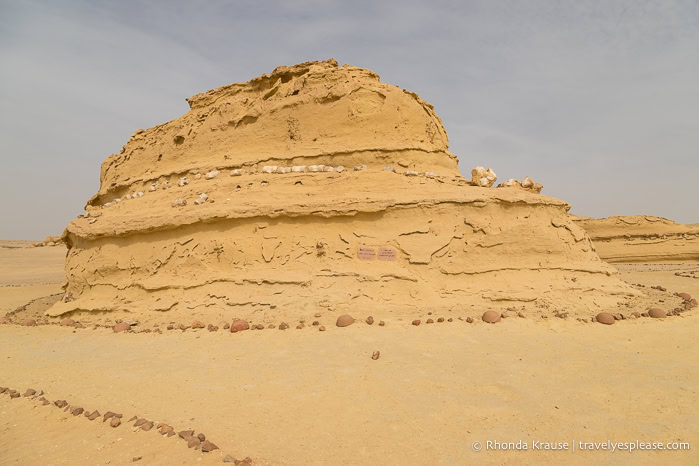
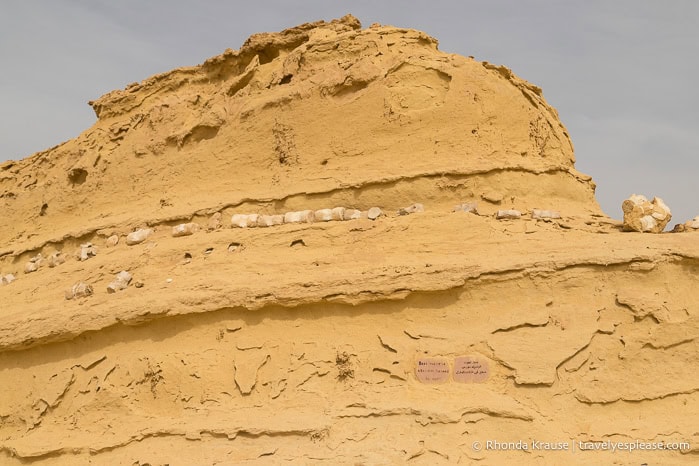



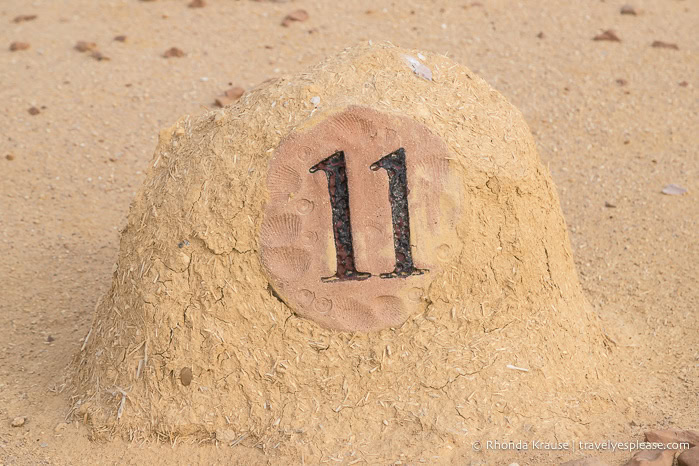
Tips for Visiting Whale Valley
Location: Wadi Al-Hitan is located in the Faiyum Governorate about 190 km southwest of downtown Cairo (approximately a 3 hr 15 min to 3 hr 30 min drive).
Getting There: Whale Valley is challenging to reach independently. The options are to rent a car and drive yourself or go with a tour company. Going with a tour company or private guide is the best option because there are police checkpoints that complicate things. My guide and I had to report our plan for the day at a checkpoint and then were given a police escort part of the way (I was told this was for safety because the area is less touristic).
- Tours typically involve travelling in 4WD vehicles because the road is rough. In my experience, we went off-roading in the desert on our way to Whale Valley.
Admission Fee: An admission fee is charged and tickets can be bought at the office on-site.
What to Bring: Wear sun protection and comfortable walking shoes. Bring water.
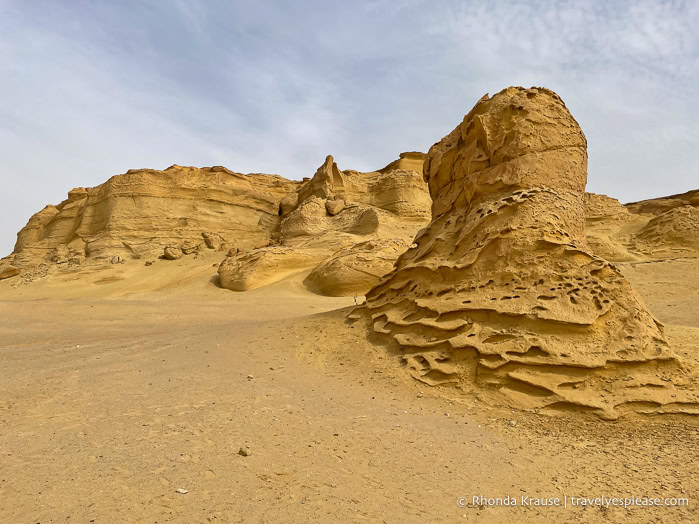
Tours of Whale Valley
Here is a trusted site where you can book tours to Whale Valley. Tours typically include visits to additional locations like Wadi El Rayan and the Magic Lake.
Accommodations Near Whale Valley
For your convenience, here is a list of accommodations in Fayoum (the closest city to Whale Valley) and Cairo. Please consider booking your Egypt accommodations through the included link. It costs nothing extra and helps support this website. Thank you!
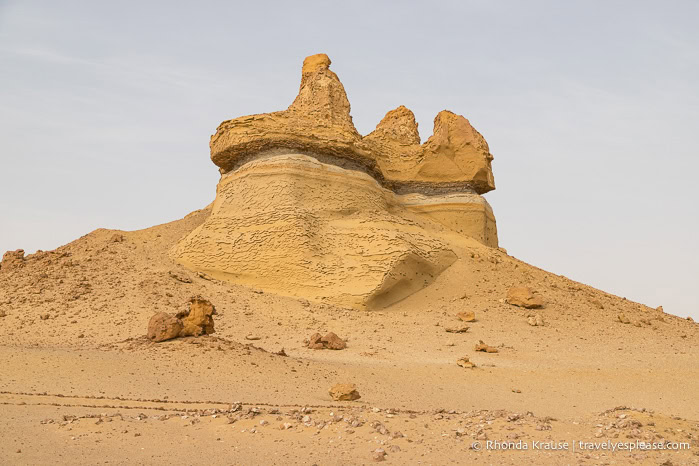
More Egypt Destinations and Travel Guides
- Abu Simbel Temples- Visiting Abu Simbel on a Day Trip from Aswan
- Philae Temple Sound and Light Show- Review and Tips for Attending
